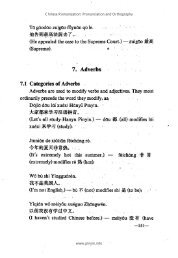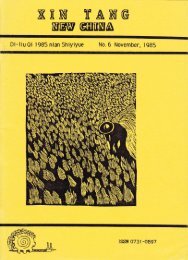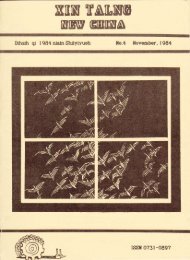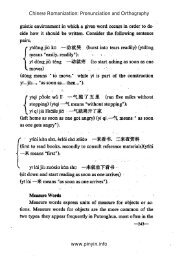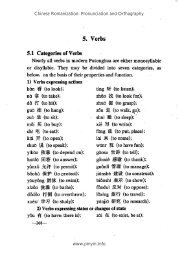XIN TANG (New China) - Pinyin.info
XIN TANG (New China) - Pinyin.info
XIN TANG (New China) - Pinyin.info
- No tags were found...
You also want an ePaper? Increase the reach of your titles
YUMPU automatically turns print PDFs into web optimized ePapers that Google loves.
3 KIN <strong>TANG</strong>: NEW CHINAcode. A contest held on June 14, 1984, utilizing such asystem, achieved a record output of 116.7 characters perminute automatically.4. How to arrange Chinese characters In serial order hasalways posed a difficult problem. The new, efficient, andconvenient way Is to arrange the characters according totheir sound In <strong>Pinyin</strong> alphabet order. This new serial orderhas recently been applied to the Greater Encvclopaedla il1Cb1na (80 volumes) and other Important publications.5. <strong>Pinyin</strong> Is now not only the national standard of <strong>China</strong>,but also the International standard adopted by ISO and UN fortranscribing Chinese. But <strong>Pinyin</strong> Is stili not considered asecond legal written language, only an· auxiliary to Chinesecharacters.Beginning from the late Qing dynasty thelanguage Refonn Movement started in <strong>China</strong>, with theaim of modernizing Chinese language, both spoken andwritten. After the revolution of 1911. the earlyBeijing Government of the Republic of <strong>China</strong> promotedthe National Language (6uoyu). changed the style ofwriting from classical to vernacular, and in 1918adopted the Sound-Notating Symbols in characterfonn (Zhuyin Fuhao). In 1928 the NationalistGovemment in Nanking adopted the National languageRomanization (Guoyu Romazi).ln 1958 the govemmentof the People's Republic of <strong>China</strong> summarized theLanguage Refonn Movement as consisting of threemain tasks: 1. the simplification of the Chinesecharacters, 2. the popularization of the CommonSpeech (Putonghua), and 3. the promotion of therevised Chinese romanization caned <strong>Pinyin</strong> (Hanyu<strong>Pinyin</strong> Fang·an). Of these three, romanization is themost crucial task.After the interruption caused by the so-caned·ten years' calamity· (Cultural Revolution. 1966-1916). the Committee for Language Refonn wasrestored and reorganized. A new Research Institute of



